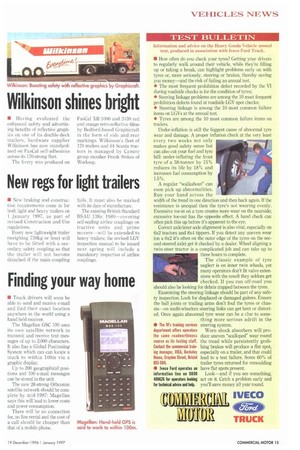TEST BULLETIN
Page 17

If you've noticed an error in this article please click here to report it so we can fix it.
Information and advice on the Heavy Goods Vehicle annual test, produced in association with Iveco Ford Truck.
• How often do you check your tyres? Getting your drivers to regularly walk around their vehicle, while they're filling up or taking a break, can highlight problems early on with tyres or, more seriously, steering or brakes, thereby saving you money—and the risk of failing an annual test.
• The most frequent prohibition defect recorded by the VI during roadside checks is for the condition of tyres; • Steering linkage problems are among the 10 most frequent prohibition defects found at roadside WV spot checks; • Steering linkage is among the 10 most common failure items on LGVs at the annual test.
• Tyres are among the 10 most common failure items on trailers.
Under-inflation is still the biggest cause of abnormal tyre wear and damage. A proper inflation check at the very least every two weeks not only makes good safety sense but can also cut your fuel and tyre bill: under-inflating the front tyre of a 38-tonner by 15% reduces its life by 18% and increases fuel consumption by L5%.
A regular "walkabout" can soon pick up abnormalities. Run your hand across the width of the tread in one direction and then back again. If the resistance is unequal then the tyre's not wearing evenly. Excessive toe-in on a tyre creates more wear on the nearside; excessive toe-out has the opposite effect A hand check can often pick this up before it's apparent to the eye.
Correct axle/inter-axle alignment is also vital, especially on 6x2 tractors and 8x4 tippers. If you detect any uneven wear (on a 6x2 it's often on the outer edge of the tyres on the second-steered axle) get it checked by a dealer. Wheel aligning a twin-steer tractor is a complicated job and can take up to three hours to complete.
The classic example of tyre neglect is on inner twin wheels, yet many operators don't fit valve extensions with the result they seldom get checked. If you run off-road you should also be looking for debris trapped between the tyres.
Examining the steering linkage should be part of any safety inspection. Look for displaced or damaged gaiters. Ensure the ball joints or trailing arms don't foul the tyres or chassis—on multi-wheelers steering links can get bent or distorted. Once again abnormal tyre wear can be a clue to some thing more serious adrift in the • The VI's training services steering system,
department offers operators Worn shock absorbers will prothe same roadworthiness duce uneven "scalloped" wear round course as its testing staff. the tread while persistently grabContact the commerial trainbing brakes will produce a flat spot, Mg manager, VIEA, Berkeley especially on a trailer, and that could House, Croydon Street, Bristol lead to a test failure. Some 60% of ISSODA. trailer tyres returned for remoulding • Iveco Ford operates an have flat spots present.
information line on 0800 Look—and if you see something, 400626 for operators looking act on it. Catch a problem early and for technical advice and help, you'll save money all year round.








































































































































